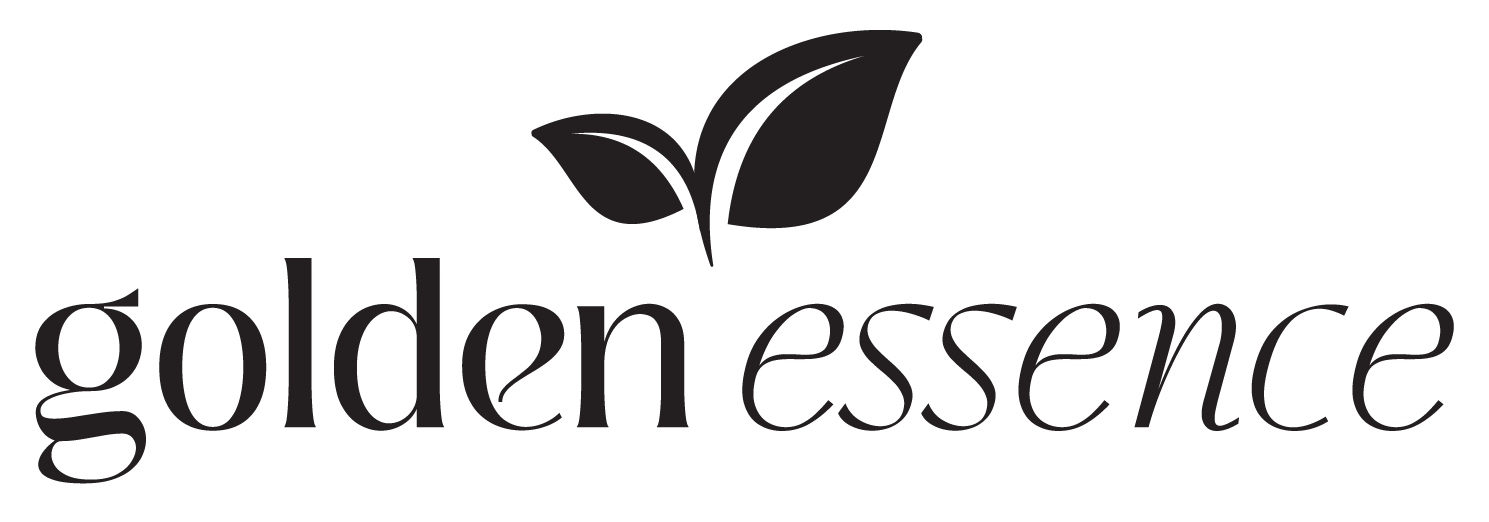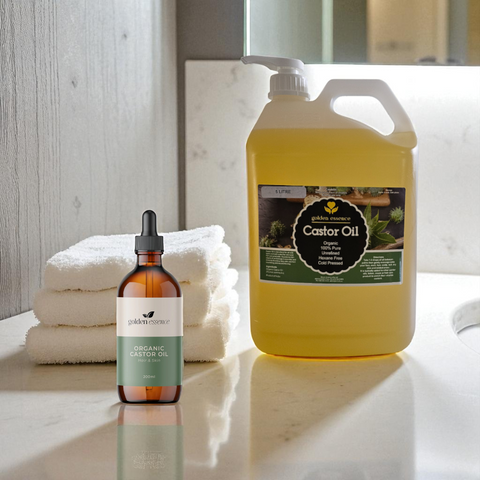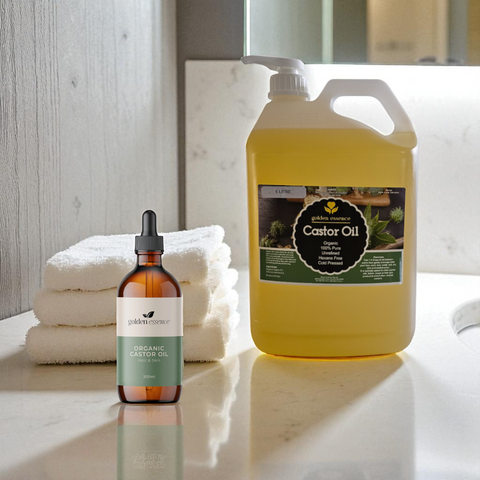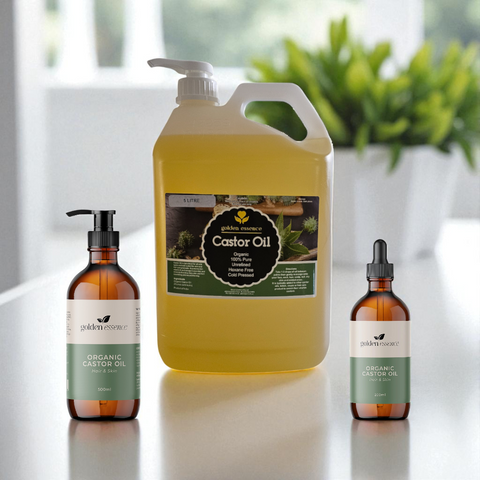
Glass vs Food-Grade HDPE: How We Keep Castor Oil Pure — From India to You
A thorough guide for home shoppers and business buyers — plain-English explanations with light technical notes beneath each section.
Why this matters
Layman’s view: We hear passionate opinions: “Should be in glass!”, “Plastic ruins oil!”, “Castor oil ‘draws’ chemicals.” We take this seriously. The truth is: both amber glass and certified food-grade HDPE safely protect castor oil when used correctly. We use each where it makes the most sense — and we’ll show you exactly how.
Light technical note
“Food-grade” means the packaging is formulated and manufactured to meet food-contact safety rules. In Australia, food-contact materials are regulated via the Food Standards Code and guidance from FSANZ and state authorities; suppliers must ensure packaging is suitable and safe for its intended use (no harmful migration into contents).
India → Australia: how castor oil actually travels
Layman’s view: Most global castor oil is produced in India. It doesn’t cross oceans in tiny glass bottles — that would be fragile, heavy, and costly. Instead, oil is shipped in robust bulk: lined steel drums, food-grade HDPE drums, or IBCs (totes). That’s the worldwide norm for moving edible oils safely over weeks at sea.
Light technical note
Industry data consistently identifies India as the dominant producer (≈85% of castor seed/oil). Bulk packaging choices prioritise seal integrity, chemical compatibility, and light/oxygen control; lined steel and certified HDPE meet food-contact requirements and withstand transport stresses. IBCs are engineered for mass handling of liquids.
Where Golden Essence sits in the chain
Layman’s view: Think of us as the receiver/packer in Australia. Bulk oil arrives sealed. We carefully decant it either directly into amber glass (for customers who prefer glass) or into food-grade HDPE for mid-bulk sizes (5L-100L) and bulk buyers.
Light technical note
We specify virgin, food-grade HDPE for decant packaging (no BPA or phthalate plasticisers), and follow good handling practices to minimise oxygen and light exposure during transfer. FSANZ advises using food-safe materials and avoiding reuse of non-food-safe containers.
Glass: premium, inert & presentation-friendly
Layman’s view: Amber glass looks and feels premium, blocks light, and is completely inert. It’s perfect for small sizes used regularly at home or in clinics — and for anyone who simply prefers glass.
Light technical note
Glass offers excellent oxygen and vapour barrier performance; amber tint reduces UV-driven oxidation. For small packs used within typical shelf life, weight and fragility are manageable, while purity and presentation are maximised.
Food-grade HDPE: practical, durable & safe
Layman’s view: For 5–100 L, HDPE shines: it’s light to carry, tough (won’t shatter), keeps costs fair, and — when it’s food-grade — it doesn’t taint or “ruin” the oil.
Light technical note
HDPE (resin code #2) is a high-density polyolefin with low permeability and strong chemical resistance; it’s the same family of plastic used widely for milk and juice bottles in Australia. Food-grade HDPE uses virgin resins and must meet food-contact requirements; authorities provide guidance to minimise chemical migration and ensure suitability for use.
“Isn’t plastic just plastic?” — addressing common objections
- “It might be organic, but it’s in plastic.” Food-grade HDPE is formulated for food/oils and tested for safe contact. The material class and manufacturing standard are what matter — not the word “plastic” alone.
- “Castor oil is a drawing oil — it will pull chemicals.” Problems arise with inferior plastics or heat/UV abuse. In certified HDPE, kept cool/dark and sealed, migration is controlled within regulatory limits for food contact. (We do not use post-consumer recycled HDPE for oils precisely to avoid NIAS/migration concerns seen in PCR streams.)
- “Glass is always better.” Glass is excellent for small volumes. For mid-bulk, glass becomes heavy, fragile, and costly to ship; food-grade HDPE provides safe handling and value without compromising oil quality.
HDPE vs “cheap plastic”: how manufacturing differs
Layman’s view: Not all plastic is equal. “Food-grade HDPE” is made to a higher standard than bargain, non-food plastics. That standard is why supermarket milk sits safely in HDPE — and why mid-bulk oils do, too.
Light technical note
Food-grade HDPE uses virgin resin (no reclaimed contaminants), controlled polymerisation and additives, and good manufacturing practice to meet food-contact rules (e.g., suitability, no harmful transfer). By contrast, low-grade or inappropriate plastics may contain residual monomers or plasticisers with higher migration potential. Regulators in AU/NZ emphasise “packaging must be suitable for its intended use” and provide migration guidance.
How mid-bulk moves (5–100 L) in Australia
Layman’s view: 5–100L jerry cans/cubes ship via parcel or freight — boxed or on mini-pallets. One person can carry them; you don’t need a forklift or drum pump. That’s why so many homes, clinics, and makers choose these sizes.
Light technical note
HDPE cubes/jerries use thick walls, tight closures, and often opaque bodies for light protection. For larger liquid logistics, Australia also relies on IBCs and drums; NHVR documents IBC handling in road transport.

Why 5–100 L hits the sweet spot (home & business)
- Home shoppers: better value per mL, fewer reorders, less packaging waste.
- Clinics & spas: reliable stock without the handling/storage burden of 200 kg drums.
- Makers/resellers: bulk economics without overcapitalising — open one jerry at a time and keep the rest sealed.
Light technical note
Contract packers of edible oils in AU commonly work across formats from 4–20 L, IBCs, and drums — reflecting a spectrum where mid-bulk balances ergonomics, safety, and cost for many users.
Steel drums (and why we mention them)
Layman’s view: Most castor oil begins its journey in lined steel drums or food-grade IBCs because they’re the safest, strongest way to cross oceans. We then decant into glass or HDPE depending on your order.
Light technical note
Steel drums and IBCs are designed for long-haul liquids; packaging suppliers for castor oil routinely specify these for export from India. It’s normal for an edible oil to be shipped in bulk, then packed down locally for retail and mid-bulk.
Store it like a pro (glass or HDPE)
- Keep containers cool and dark (cupboard or storeroom; avoid windows and heat).
- Seal tightly after each use to limit oxygen exposure.
- For larger packs, decant a small “working” bottle and keep the main jerry sealed.
Light technical note
FSANZ advises using appropriate food-safe packaging and avoiding reuse of unsuitable containers; general migration risk rises under heat/UV abuse, so good storage practice matters more than the substrate alone.
Bottom line
We trust both amber glass and food-grade HDPE — each is the right tool at the right size. Glass is premium and inert for smaller formats. Certified HDPE is practical, durable and safe for mid-bulk. Both protect the purity of our organic, cold-pressed castor oil when used correctly.






